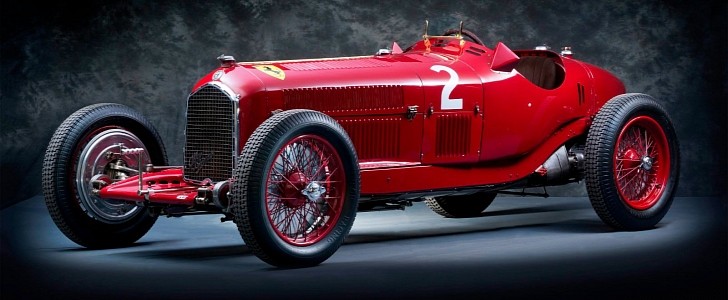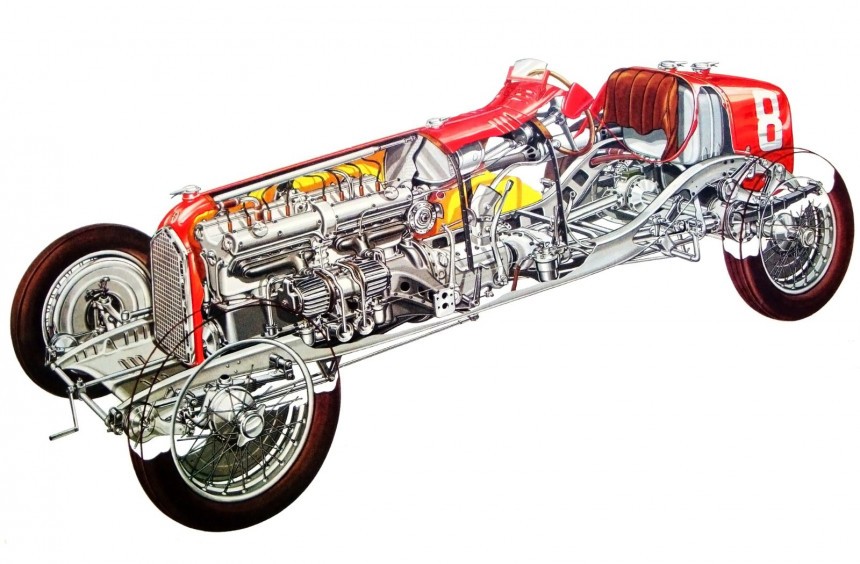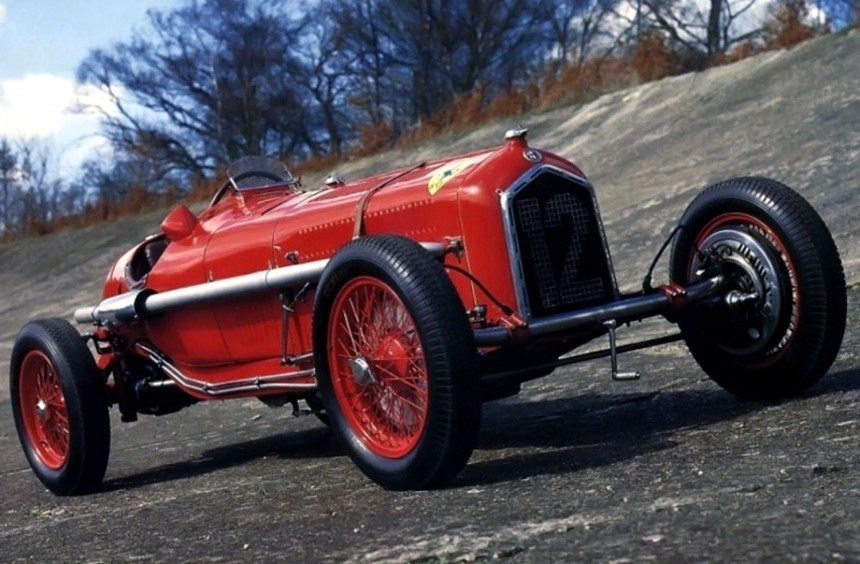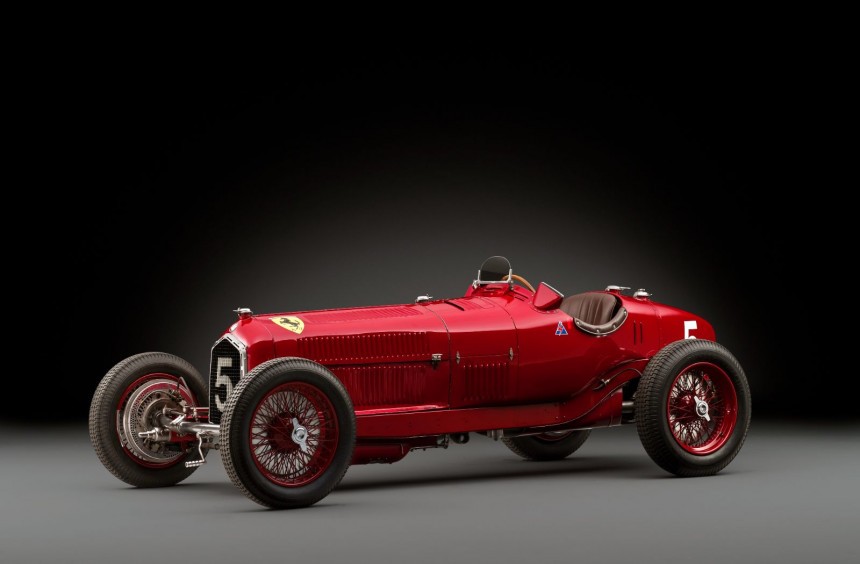Introduced in the early thirties, the innovative Alfa Romeo P3 won most of the races it competed in, setting new standards for the Grand Prix cars or the era. It is considered the first genuine single-seater and an important milestone in the history of motorsport.
The story starts in 1931 when designer Vittorio Jano was commissioned to create a worthy successor for the Tipo A, the manufacturer’s first successful race car which debuted in 1924 and became outdated.
Jano went back to the drawing board and came up with a completely new design after an arduous development process. While the Tipo A had a complicated powertrain, which consisted of two parallel in-line engines mated to a couple of gearboxes, the new car originally dubbed Tipo B, featured a straight-eight comprising of two cast iron blocks with fixed aluminum alloy heads, each with its own overhead camshaft. The unit was fed by two carburetors and boosted by two Roots superchargers operated by a gear train mounted centrally, between the two blocks. Initially, it displaced 2.6 liters (2,654 cc) and delivered a maximum output of 215 hp at 5600 rpm.
The four-speed gearbox was paired to the front-mounted engine via a dry multi-plate clutch. Two drive shafts arranged in a V shape exited the differential which was installed next to the transmission and drove the rear wheels through bevel gear pairs.
This innovative design enabled Jano to place the driver’s seat centrally, between the two drive shafts, a solution that exponentially lowered the center of gravity and improved weight distribution. Coupled with an overall weight of just 1,543 pounds (700 kg), it could easily reach a top speed of 144 mph (232 kph) but more importantly, it was far more agile than its predecessor.
With all these improvements, the car subsequently rechristened P3 was introduced midway through the 1932 Grand Prix season. It debuted on home turf at the original Monza Circuit, which back then included the road track and the high-speed loop, for a total of 6.2 miles (10 km) per lap. In the five-hour race, Tazio Nuvolari dominated from the start, managing to lap Fagioli's new 16-cylinder Maserati V5, which came in second.
The resounding victory proved that the P3 was a successful design, but the victories didn’t stop there, as Alfa Romeo would go on to win six additional races that year, including all three major events in Italy, France, and Germany.
In 1933, the Italian carmaker was hit by financial difficulties and initially decided to withdraw its Alfa Corse team from the European Championship. This left the door open for Enzo Ferrari’s Scuderia who would go on to compete as Alfa’s de-facto works team, albeit with older, less effective cars.
In August, the team was finally cleared to use the P3s which had been locked up in a garage for the first 25 events, and after receiving some minor tweaks along with a couple of Ferrari logos, the cars would go on to win six of the last eleven races of the season.
For 1934, the new regulations brought larger bodywork constraints, so to counteract this, the powerplant’s displacement was increased to 2.9 liters (2905 cc) which led to a performance boost of 40 hp.
That season, Louis Chiron won the French Grand Prix at Montlhery, one of the most prestigious races on the calendar and the P3s went on to cross the finish line the first eighteen more times.
The following year, full management of the cars was handed down to Scuderia Ferrari who made several modifications to the suspension and also the brakes which were now hydraulic. Despite this, the P3s were utterly uncompetitive against the superior Mercedes and Auto-Union racers.
However, for the German Grand Prix held at the legendary Nürburgring, the engine that powered Tazio Nuvolari’s car was bored out to 3.1 liters (3,165 cc), which lead to an output of 265 hp. The Italian driver managed to pull off an upset against the Germans on their home turf after an amazing performance, despite suffering a punctured tire in the early stages of the race. Although inferior to the newer cars in the competition, the legendary Alfa Romeo still won another fifteen events that season.
Despite a tumultuous career that only lasted three years, the P3 achieved 46 total victories, earning its place among the greatest race cars of all time. The innovations implemented by Vittorio Jano made it extremely agile and the first genuine single-seater, inspiring other engineers to do the same and paving the way for the race cars of the modern era.
Thirteen of the fifteen units built between 1932 and 1935 survived to this day with chassis number 50006 being auctioned off by RM Sotheby's in 2017 for well over $4,000,000. Other privately-owned chassis make occasional appearances at classic car events, such as the Chateau Impney Hill Climb where one was driven hard by Matt Grist several years ago, as you can see in the video bellow.
Jano went back to the drawing board and came up with a completely new design after an arduous development process. While the Tipo A had a complicated powertrain, which consisted of two parallel in-line engines mated to a couple of gearboxes, the new car originally dubbed Tipo B, featured a straight-eight comprising of two cast iron blocks with fixed aluminum alloy heads, each with its own overhead camshaft. The unit was fed by two carburetors and boosted by two Roots superchargers operated by a gear train mounted centrally, between the two blocks. Initially, it displaced 2.6 liters (2,654 cc) and delivered a maximum output of 215 hp at 5600 rpm.
The four-speed gearbox was paired to the front-mounted engine via a dry multi-plate clutch. Two drive shafts arranged in a V shape exited the differential which was installed next to the transmission and drove the rear wheels through bevel gear pairs.
With all these improvements, the car subsequently rechristened P3 was introduced midway through the 1932 Grand Prix season. It debuted on home turf at the original Monza Circuit, which back then included the road track and the high-speed loop, for a total of 6.2 miles (10 km) per lap. In the five-hour race, Tazio Nuvolari dominated from the start, managing to lap Fagioli's new 16-cylinder Maserati V5, which came in second.
The resounding victory proved that the P3 was a successful design, but the victories didn’t stop there, as Alfa Romeo would go on to win six additional races that year, including all three major events in Italy, France, and Germany.
In August, the team was finally cleared to use the P3s which had been locked up in a garage for the first 25 events, and after receiving some minor tweaks along with a couple of Ferrari logos, the cars would go on to win six of the last eleven races of the season.
For 1934, the new regulations brought larger bodywork constraints, so to counteract this, the powerplant’s displacement was increased to 2.9 liters (2905 cc) which led to a performance boost of 40 hp.
That season, Louis Chiron won the French Grand Prix at Montlhery, one of the most prestigious races on the calendar and the P3s went on to cross the finish line the first eighteen more times.
The following year, full management of the cars was handed down to Scuderia Ferrari who made several modifications to the suspension and also the brakes which were now hydraulic. Despite this, the P3s were utterly uncompetitive against the superior Mercedes and Auto-Union racers.
Despite a tumultuous career that only lasted three years, the P3 achieved 46 total victories, earning its place among the greatest race cars of all time. The innovations implemented by Vittorio Jano made it extremely agile and the first genuine single-seater, inspiring other engineers to do the same and paving the way for the race cars of the modern era.
Thirteen of the fifteen units built between 1932 and 1935 survived to this day with chassis number 50006 being auctioned off by RM Sotheby's in 2017 for well over $4,000,000. Other privately-owned chassis make occasional appearances at classic car events, such as the Chateau Impney Hill Climb where one was driven hard by Matt Grist several years ago, as you can see in the video bellow.














